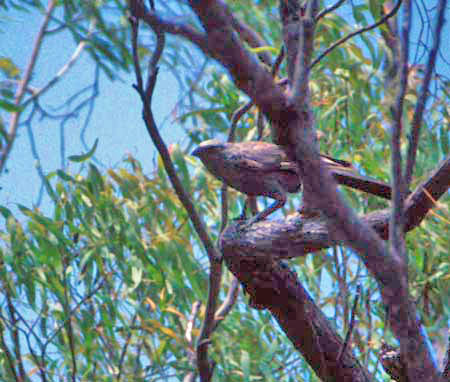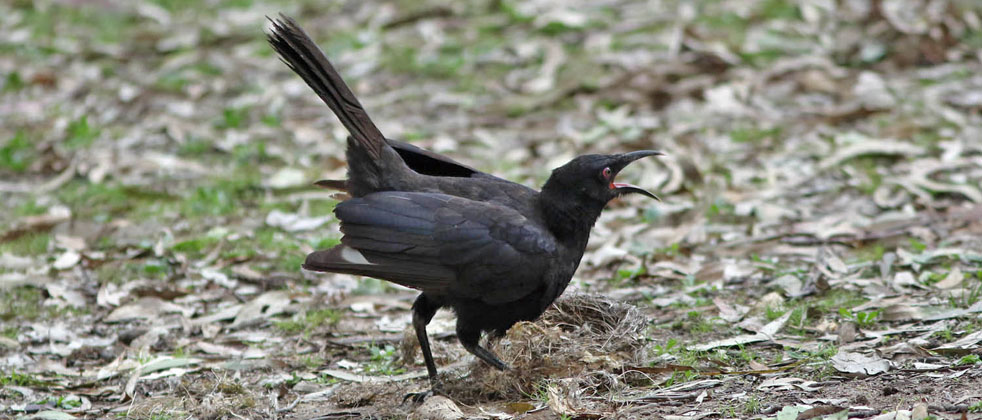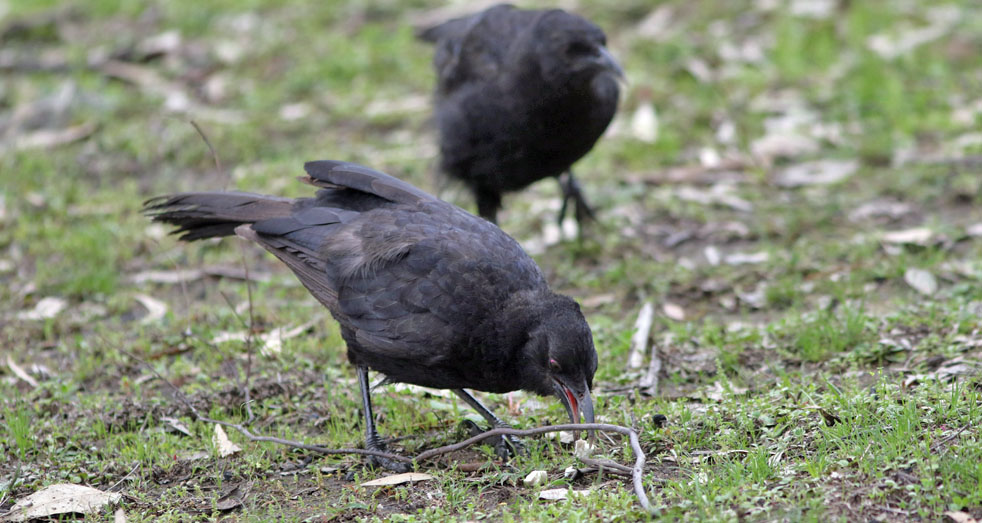| |
AUSTRALIAN MUDNESTERS Corcoracidae |
- 2 species in Australia
- DR personal total: 2 species (100%), 2 photo'd
|
 The Australian Mudnesters is a small Australian family comprised of just two species: Apostlebird (left) and White-winged Chough (below). The two species are in different genera and do not look much alike, but they have similar behaviors and they both build mud nests. A third Australian bird builds mud nests: Magpie-lark Grallina cyanoleuca. At one time Magpie-lark (and a related species in New Guinea) were considered a family ["Grallinidae"] and were called "Mudnest Builders," causing confusion. By the 1990s, early genetic evidence showed that Magpie-lark was embedded in the Monarch family (Monarchidae; e.g., Baverstock et al. 1992, Sibley 1996). To avoid that confusion, I used "Apostlebirds" for the Corcoracidae in the past, but that really covers just one species. Some literature calls the family the "White-winged Chough and Apostlebird," but that seems needlessly pedantic. Perhaps enough time has passed to use the name Australian Mudnesters for the Corcoracidae alone (as did the Handbook of the Birds of the World; Rowley & Russell 2009). The Australian Mudnesters is a small Australian family comprised of just two species: Apostlebird (left) and White-winged Chough (below). The two species are in different genera and do not look much alike, but they have similar behaviors and they both build mud nests. A third Australian bird builds mud nests: Magpie-lark Grallina cyanoleuca. At one time Magpie-lark (and a related species in New Guinea) were considered a family ["Grallinidae"] and were called "Mudnest Builders," causing confusion. By the 1990s, early genetic evidence showed that Magpie-lark was embedded in the Monarch family (Monarchidae; e.g., Baverstock et al. 1992, Sibley 1996). To avoid that confusion, I used "Apostlebirds" for the Corcoracidae in the past, but that really covers just one species. Some literature calls the family the "White-winged Chough and Apostlebird," but that seems needlessly pedantic. Perhaps enough time has passed to use the name Australian Mudnesters for the Corcoracidae alone (as did the Handbook of the Birds of the World; Rowley & Russell 2009).
I joked in my initial page that "Apostlebirds always come in groups of 12 birds following a charismatic leader .... okay, just kidding." Yet they are, in fact, named for the average group size of about a dozen — like the 12 biblical apostles. The typical group actually ranges from 8-18 birds (Dow 1980). |
 |
 White-winged Chough (above, right, and below) recalls corvids, and is named for the Eurasian choughs (genus Pyrrhocorax) in the crow family (Corvidae). In fact, for many years, both species in this Australian family were considered to be corvids. Placing them in their own family did not occur until the 1920s-1930s (Rowly & Russell 2009). Both Apostlebird and White-winged Chough inhabit open stands of eucalypt woods — this habitat is generally dry and inland in eastern and southeastern Australia — and for both species it can be said that they "live in sociable groups, build solid mud nests and assist each other in breeding" (Simpson & Day 1996). Apostlebirds forage as loose parties in open woodlands, omnivorous in their search for almost anything to eat. In summer they take many insects on the ground, but supplement their diet with seeds in the winter. During "plagues" of mice they will eat them (Blakers et al. 1984, Rowley & Russell 2009). White-winged Chough (above, right, and below) recalls corvids, and is named for the Eurasian choughs (genus Pyrrhocorax) in the crow family (Corvidae). In fact, for many years, both species in this Australian family were considered to be corvids. Placing them in their own family did not occur until the 1920s-1930s (Rowly & Russell 2009). Both Apostlebird and White-winged Chough inhabit open stands of eucalypt woods — this habitat is generally dry and inland in eastern and southeastern Australia — and for both species it can be said that they "live in sociable groups, build solid mud nests and assist each other in breeding" (Simpson & Day 1996). Apostlebirds forage as loose parties in open woodlands, omnivorous in their search for almost anything to eat. In summer they take many insects on the ground, but supplement their diet with seeds in the winter. During "plagues" of mice they will eat them (Blakers et al. 1984, Rowley & Russell 2009).
White-winged Chough is a formidable bird: long-billed, inquisitive, raucous, and with strong legs and big feet (right). It is one of very few species to adapt to the transformation of native habitat to planted pines (Frith et al. 1979). The species forages and wanders within a territory in small groups; the usual groups size is 4-8 birds (Blakers et al. 1984). While Apostlebird is gray, White-winged Chough is black with white wing patches. The white patches are formed by black-and-white patterned primaries, but one does not often see those patches until the birds fly (below). |
 |
Sibley & Monroe (1990) showed that this small Australian family was one part of the great corvid assemblage that arose in Australasia. Sibley (1996) noted that various biochemical methods confirmed the close relationship of the two species in this family (and the quite distant relationship of the Magpie-lark). The habit of foraging in flocks in expanded families, and group nesting help, reminds me of the American Crows Corvus brachyrhynchos in my California backyard, and the dependence on population outbreaks of various prey recalls local Yellow-billed Magpies Pica nuttalli focus on termite flights. Thus, although a half-a-world away, they are corvoid indeed. Recent molecular studies suggest that the Corcoracidae are most closely to birds-of-paradise (Paradisaeidae) or to melampittas (Melampittidae; Reddy & Cracraft 2007, Jønsson et al. 2011, Aggerbeck et al. 2014).
In addition to confusion over the English name of the family, the scientific name has also been the subject of dispute. Rowley & Russell (2009) argued that the name Struthideidae had priority over the name Corcoracidae, and "the Struthideidae" is the name used by them in the Handbook of the Birds of the World series. It addition, the formal scientific name of White-winged Chough as spelled as Corcorax "melanoramphos" in that and other literature. Eventually the ICZN (in opinion 2380) resolved the controversies: the scientific name of the White-winged Chough is now Corcorax melanorhamphos, and they conserved the family name Corcoracidae over Struthideidae. A final shot of a curious Corcorax melanorhamphos is below. |
 |
| |
Photos: The Apostlebird Struthidea cinerea was part of a small flock north of Mt. Carbine, Queensland, Australia, in Jan 1998. All photos of White-winged Chough Corcorax melanorhamphos were from a flock in Sundown NP, Queensland, Australia, on 2 Sep 2016.
All photos © Don Roberson; all rights reserved.
Bibliographic note: There is no "family book" per se but a good introduction to this family, with some excellent photos, is in Rowley & Russell (2009).
Literature cited:
Aggerbeck, M., J. Fjeldså, L. Christidis, P.H. Fabre, and K.A. Jønsson. 2014. Resolving deep lineage divergences in core corvoid passerine birds supports a proto-Papuan island origin. Molec. Phylog. Evol. 70: 272–285.
Baverstock, P.R., R. Schodde, L. Christidis, M. Krieg, and J. Birrell. 1992. Evolutionary relationships of the Australasian mud-nesters (Grallinidae, Corcoracidae): immunological evidence. Australian J. Zool. 40: 173–179.
Blakers, M., S. J.J.F. Davies, and P.N. Reilly. 1984. The Atlas of Australian Birds. Royal Australian Ornith. Union, Melbourne Univ. Press, Carlton, Victoria.
Dow, D.D. 1980. Communally breeding Australian birds with an analysis of distributional and environmental factors. Emu 80: 121-140.
Frith, H.J., consulting ed. 1979. The Reader's Digest Complete Book of Australian Birds. 2d revised ed. Reader's Digest Services, Ltd., Sydney.
Jønsson, K.A., P.H. Fabre, R.E. Ricklefs, and J. Fjeldså. 2011. Major global radiation of corvoid birds originated in the proto-Papuan archipelago. Proc. Nat. Acad. Sciences 108: 2328–2333.
Reddy, S., and J. Cracraft. 2007. Old World shrike-babblers (Pteruthius) belong with New World vireos (Vireonidae). Molec. Phylog. Evol. 44: 1352–1357.
Rowley, I.C.R., and E.M. Russell. 2009. Family Struthideidae (Australian Mudnesters), pp. 272–285 in Handbook of the Birds of the World (del Hoyo, J., A. Elliott & D.A. Christie, eds). Vol. 14. Lynx Edicions, Barcelona, Spain.
Sibley, C.G. 1996. Birds of the World, on diskette, Windows version 2.0. Charles G. Sibley, Santa Rosa, CA.
Sibley, C. G., and J. E. Ahlquist. 1990. Phylogeny and Classification of Birds: A Study in Molecular Evolution. Yale Univ. Press, New Haven, CT.
Simpson, K, and N. Day. 1996. A Field Guide to the Birds of Australia, revised 5th ed. Penguin Books Australia Ltd., Ringwood, Victoria, Australia.
|
|
|




 The Australian Mudnesters is a small Australian family comprised of just two species: Apostlebird (left) and White-winged Chough (below). The two species are in different genera and do not look much alike, but they have similar behaviors and they both build mud nests. A third Australian bird builds mud nests: Magpie-lark Grallina cyanoleuca. At one time Magpie-lark (and a related species in New Guinea) were considered a family ["Grallinidae"] and were called "Mudnest Builders," causing confusion. By the 1990s, early genetic evidence showed that Magpie-lark was embedded in the Monarch family (Monarchidae; e.g., Baverstock et al. 1992, Sibley 1996). To avoid that confusion, I used "Apostlebirds" for the Corcoracidae in the past, but that really covers just one species. Some literature calls the family the "White-winged Chough and Apostlebird," but that seems needlessly pedantic. Perhaps enough time has passed to use the name Australian Mudnesters for the Corcoracidae alone (as did the Handbook of the Birds of the World; Rowley & Russell 2009).
The Australian Mudnesters is a small Australian family comprised of just two species: Apostlebird (left) and White-winged Chough (below). The two species are in different genera and do not look much alike, but they have similar behaviors and they both build mud nests. A third Australian bird builds mud nests: Magpie-lark Grallina cyanoleuca. At one time Magpie-lark (and a related species in New Guinea) were considered a family ["Grallinidae"] and were called "Mudnest Builders," causing confusion. By the 1990s, early genetic evidence showed that Magpie-lark was embedded in the Monarch family (Monarchidae; e.g., Baverstock et al. 1992, Sibley 1996). To avoid that confusion, I used "Apostlebirds" for the Corcoracidae in the past, but that really covers just one species. Some literature calls the family the "White-winged Chough and Apostlebird," but that seems needlessly pedantic. Perhaps enough time has passed to use the name Australian Mudnesters for the Corcoracidae alone (as did the Handbook of the Birds of the World; Rowley & Russell 2009).  White-winged Chough (above, right, and below) recalls corvids, and is named for the Eurasian choughs (genus Pyrrhocorax) in the crow family (Corvidae). In fact, for many years, both species in this Australian family were considered to be corvids. Placing them in their own family did not occur until the 1920s-1930s (Rowly & Russell 2009). Both Apostlebird and White-winged Chough inhabit open stands of eucalypt woods — this habitat is generally dry and inland in eastern and southeastern Australia — and for both species it can be said that they "live in sociable groups, build solid mud nests and assist each other in breeding" (Simpson & Day 1996). Apostlebirds forage as loose parties in open woodlands, omnivorous in their search for almost anything to eat. In summer they take many insects on the ground, but supplement their diet with seeds in the winter. During "plagues" of mice they will eat them (Blakers et al. 1984, Rowley & Russell 2009).
White-winged Chough (above, right, and below) recalls corvids, and is named for the Eurasian choughs (genus Pyrrhocorax) in the crow family (Corvidae). In fact, for many years, both species in this Australian family were considered to be corvids. Placing them in their own family did not occur until the 1920s-1930s (Rowly & Russell 2009). Both Apostlebird and White-winged Chough inhabit open stands of eucalypt woods — this habitat is generally dry and inland in eastern and southeastern Australia — and for both species it can be said that they "live in sociable groups, build solid mud nests and assist each other in breeding" (Simpson & Day 1996). Apostlebirds forage as loose parties in open woodlands, omnivorous in their search for almost anything to eat. In summer they take many insects on the ground, but supplement their diet with seeds in the winter. During "plagues" of mice they will eat them (Blakers et al. 1984, Rowley & Russell 2009).